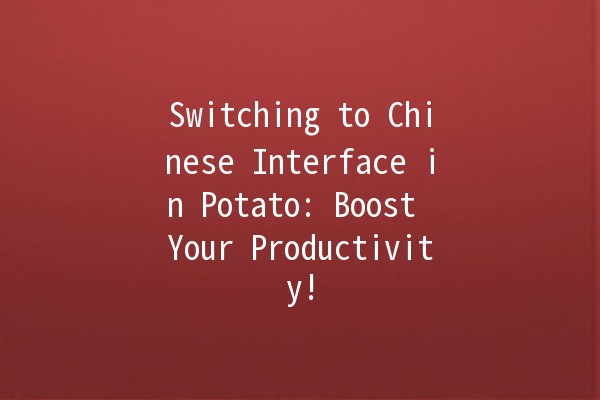In today’s fastpaced digital world, effective software tools can make or break our productivity levels. If you're using the Potato software and need to switch to its Chinese interface, this article offers practical tips to help you navigate through the process efficiently. The Potato software is wellknown for its userfriendly design, but understanding how to switch languages can enhance your overall experience, especially if you're a Chinese speaker or want to work in this language. Let's dive into the essential tips and tricks for switching to the Chinese interface in Potato, ensuring you can work smarter, not harder.
Why Switch to a Chinese Interface? 🇨🇳
In our increasingly globalized world, language barriers can hinder communication and productivity. The Potato software provides users with a Chinese interface option, catering to those who prefer working in their native tongue. Switching to Chinese can enhance reading comprehension, enable quicker responses, and foster a more comfortable working environment. Additionally, for teams collaborating internationally, using a common language like Chinese can streamline discussions and tasks.

To start, you'll want to locate the language settings within Potato. Here’s how you do it:
Open the Potato application on your device.
Navigate to the Settings menu—often represented by a gear icon in the top right corner.
Look for the Language option. This is usually categorized under General Settings or similar headings.
Example: If you opened Potato on a Windows computer, find the settings menu and click on "Language." Select "中文" (Chinese) from the dropdown list.
Switching to the Chinese interface means you'll encounter various features and elements labeled in Chinese. Familiarizing yourself with these terms will ease navigation. Here are some common interface terms in both English and Chinese:
File (文件)
Edit (编辑)
View (视图)
Help (帮助)
Practical Tip: Create a cheat sheet for frequent actions you perform within the application to reference while you adjust to the new language setting.
Once you have the interface set to Chinese, mastering keyboard shortcuts can significantly enhance your productivity. Potato typically offers various shortcuts that can still be utilized regardless of the language. Here are some common shortcuts you can practice:
Ctrl + S: Save current document
Ctrl + Z: Undo the last action
Ctrl + C: Copy selected item
Ctrl + V: Paste copied item
Example Application: This allows you to work faster without having to navigate through the menus constantly, ultimately saving you time.
Potato's interface not only allows for language switching but also provides personalization options. Take advantage of these features:
Change themes or colors to suit your preferences, making the application more visually appealing and easier to use.
Adjust text sizes to enhance readability when content is presented in Chinese.
Implementation Tip: Explore the settings after switching to Chinese and tweak configurations to minimize strain on your eyes during extended use.
When working in a specific language, utilizing community resources can provide valuable support. Consider joining forums or user groups dedicated to Chinesespeaking Potato users. Here’s how these resources can benefit you:
Knowledge Sharing: Learn from others who may share productivity hacks or solutions to similar challenges.
Tutorials and Guides: Frequently, users will post helpful guides on how to maximize the use of features—often in the language setting you prefer.
Example: Joining a WeChat group specifically for Potato users can provide you with realtime assistance and updates on software improvements.
Tackling Common Questions About Switching to Chinese in Potato
To revert the language settings, follow the same steps for accessing settings and choose "English" from the language dropdown.
No, changing the interface language only alters how menus and tooltips are displayed; it does not impact the content of your documents.
Yes, utilizing online resources or language learning apps can help familiarize you with commands in both languages.
Ensure your Potato software is updated to the latest version. If the issue persists, check community forums for troubleshooting tips.
Yes, Potato allows users to customize keyboard shortcuts through the settings, enabling a personalized workflow that suits your needs.
Yes, Potato regularly updates its language packs to ensure comprehensive localization. Check the settings for additional downloads.
Switching to the Chinese interface in Potato can significantly enhance usability and productivity for native speakers or those familiar with the language. By learning the essential settings, utilizing keyboard shortcuts, customizing your experience, and connecting with the community, you can unlock the full potential of this powerful tool. Start exploring these productivityenhancing features today and witness how a simple interface switch can elevate your work experience! 🌟